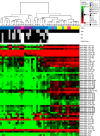miRNA expression patterns in normal breast tissue and invasive breast cancers of BRCA1 and BRCA2 germ-line mutation carriers
- PMID: 26378051
- PMCID: PMC4741663
- DOI: 10.18632/oncotarget.5617
miRNA expression patterns in normal breast tissue and invasive breast cancers of BRCA1 and BRCA2 germ-line mutation carriers
Abstract
miRNA deregulation has been found to promote carcinogenesis. Little is known about miRNA deregulation in hereditary breast tumors as no miRNA expression profiling studies have been performed in normal breast tissue of BRCA1 and BRCA2 mutation carriers. miRNA profiles of 17 BRCA1- and 9 BRCA2-associated breast carcinomas were analyzed using microarrays. Normal breast tissues from BRCA1 and BRCA2 mutation carriers (both n = 5) and non-mutation carriers (n = 10) were also included. Candidate miRNAs were validated by qRT-PCR. Breast carcinomas showed extensive miRNA alteration compared to normal breast tissues in BRCA1 and BRCA2 mutation carriers. Moreover, normal breast tissue from BRCA1 mutation carriers already showed miRNA alterations compared to non-mutation carriers. Chromosomal distribution analysis showed several hotspots containing down- or up-regulated miRNAs. Pathway analysis yielded many similarities between the BRCA1 and BRCA2 axes with miRNAs involved in cell cycle regulation, proliferation and apoptosis. Lesser known pathways were also affected, including cellular movement and protein trafficking. This study provides a comprehensive insight into the potential role of miRNA deregulation in BRCA1/2-associated breast carcinogenesis. The observed extensive miRNA deregulation is likely the result of genome-wide effects of chromosomal instability caused by impaired BRCA1 or BRCA2 function. This study's results also suggest the existence of common pathways driving breast carcinogenesis in both BRCA1 and BRCA2 germ-line mutation carriers.
Keywords: BRCA1; BRCA2; breast cancer; hereditary; miRNA.
Conflict of interest statement
There are no other actual or potential financial or personal connections or other relationships to this research that could have inappropriately influenced its results.
Figures






Similar articles
-
CCND1 and ZNF217 gene amplification is equally frequent in BRCA1 and BRCA2 associated and non-BRCA breast cancer.Neoplasma. 2010;57(4):325-32. doi: 10.4149/neo_2010_04_325. Neoplasma. 2010. PMID: 20429623
-
BRCA1 and BRCA2 mutations in males with familial breast and ovarian cancer syndrome. Results of a Spanish multicenter study.Fam Cancer. 2015 Dec;14(4):505-13. doi: 10.1007/s10689-015-9814-z. Fam Cancer. 2015. PMID: 26026974
-
PML protein expression in hereditary and sporadic breast cancer.Neoplasma. 2007;54(4):263-8. Neoplasma. 2007. PMID: 17822314
-
[Breast cancer in BRCA1/2 mutation carriers].Cesk Patol. 2016 Fall;52(4):206-209. Cesk Patol. 2016. PMID: 27869445 Review. Czech.
-
MicroRNA in breast cancer: The association with BRCA1/2.Cancer Biomark. 2017;19(2):119-128. doi: 10.3233/CBM-160319. Cancer Biomark. 2017. PMID: 28128741 Review.
Cited by
-
MicroRNA in pancreatic ductal adenocarcinoma and its precursor lesions.World J Gastrointest Oncol. 2016 Jan 15;8(1):18-29. doi: 10.4251/wjgo.v8.i1.18. World J Gastrointest Oncol. 2016. PMID: 26798434 Free PMC article. Review.
-
Multiregional Radiogenomic Assessment of Prostate Microenvironments with Multiparametric MR Imaging and DNA Whole-Exome Sequencing of Prostate Glands with Adenocarcinoma.Radiology. 2017 Jul;284(1):109-119. doi: 10.1148/radiol.2017162827. Epub 2017 Apr 28. Radiology. 2017. PMID: 28453432 Free PMC article.
-
CircRNAs and miRNAs: Key Player Duo in Breast Cancer Dynamics and Biomarkers for Breast Cancer Early Detection and Prevention.Int J Mol Sci. 2024 Dec 4;25(23):13056. doi: 10.3390/ijms252313056. Int J Mol Sci. 2024. PMID: 39684767 Free PMC article. Review.
-
In Silico Identification of a BRCA1:miR-29:DNMT3 Axis Involved in the Control of Hormone Receptors in BRCA1-Associated Breast Cancers.Int J Mol Sci. 2023 Jun 8;24(12):9916. doi: 10.3390/ijms24129916. Int J Mol Sci. 2023. PMID: 37373065 Free PMC article.
-
miRNA expression profiling of hereditary breast tumors from BRCA1- and BRCA2-germline mutation carriers in Brazil.BMC Cancer. 2020 Feb 22;20(1):143. doi: 10.1186/s12885-020-6640-y. BMC Cancer. 2020. PMID: 32087690 Free PMC article.
References
-
- Jemal A, Bray F, Ferlay J, Center MM, Ward E, Forman D. Global Cancer Statistics. CA. Cancer J. Clin. 2011;61:69–90. - PubMed
-
- GLOBOCAN. Most frequent cancers: women [Internet]. Sect. Cancer Inf. 2008 Available from: http://globocan.iarc.fr/factsheets/populations/factsheet.asp?uno=900#WOMEN.
-
- Narod S a. BRCA mutations in the management of breast cancer: the state of the art. Nat. Rev. Clin. Oncol. Nature Publishing Group. 2010;7:702–707. - PubMed
-
- Venkitaraman AR. and the Functions of BRCA1 and BRCA2. Cell. 2002;108:171–182. - PubMed
Publication types
MeSH terms
Substances
LinkOut - more resources
Full Text Sources
Other Literature Sources
Medical
Research Materials
Miscellaneous

